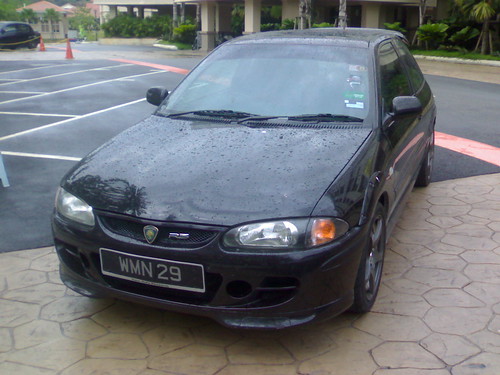 The Satria GTi was launched with a 141 bhp (105 kW) 1.8-litre Mitsubishi-sourced 4G93p engine, originally found in the Mitsubishi Lancer GTI. Additionally, the Satria GTi's engine and handling was later tuned and revised by Lotus. According to dyno chart, it can produce 130 bhp (97 kW) on wheel. Top speed 220km/h
The Satria GTi was launched with a 141 bhp (105 kW) 1.8-litre Mitsubishi-sourced 4G93p engine, originally found in the Mitsubishi Lancer GTI. Additionally, the Satria GTi's engine and handling was later tuned and revised by Lotus. According to dyno chart, it can produce 130 bhp (97 kW) on wheel. Top speed 220km/h During the involvement of Lotus,a new body kit was also adopted for the GTi for better aerodynamics. Proton claims that the Satria GTi was the fastest car it has ever produced to date.
Wheel Base 2440 mm (96.1 in)Length 3995 mm (157.3 in)
Width 1710 mm (67.3 in)
Height 1365 mm (53.7 in)
Curb Weight 1005 kg (2216 lb)
4G93 DOHC 16 Valve
- Gasoline Direct Injection (GDI)
- Total Displacement - 1834cc
- Bore - 81.0mm
- Stroke - 89.0mm
- Compression Ratio - 12:1
- Maximum Output - 96 kW (131 PS; 129 bhp) / 103 kW (140 PS; 138 bhp) @ 6,000 rpm
- Maximum Torque - 177 N·m (131 ft·lbf) @ 3,750 rpm / 181 N·m (133 ft·lbf) @ 3,500 rpm
the R3

Original Stage 1 R3s utilises the same Mitsubishi-sourced 1.8-litre, inline-4 engine as the Satria GTi (albeit with a new free-flow exhaust system), producing 140bhp (105kW) and 168 Newton meters of torque. Power is channeled to the front wheels via a five-speed manual transmission, also sourced from the GTi.
The main modification that separated the R3 from the GTi was its double stitch welded chassis, which meant the car was welded twice for increased structural rigidity, aided by the inclusion of front and rear suspension strut braces. The R3 was also stripped of its sound-deadening material and driver's airbag, which helped bring the weight down to just 995 kg. Suspension improvements included uprated springs and dampers, thicker anti-roll bars and lower ride height.
The brakes were also modified to have Anti-lock braking system removed as well as the original ventilated front discs and solid rear discs and replaced by cross-drilled and slotted DBA (Disc Brake Australia) discs all round. M1144 series brake pads were supplied by Mintex Racing.
Externally, the R3 is differentiated from the GTi by its lightweight 16-inch Advanti alloy wheels. Although they are the same size as those on the GTi, they have a five-spoke design with a gunmetal finish and wrapped in Yokohama Advan AD07 tyres. Also, the headlamps are smoked and the roof spoiler is now made of carbon fibre. Inside, the R3 has a three-spoke MOMO Tuner steering wheel, carbon fibre gearknob, titanium-effect trim and Recaro SR4 seats.
Later, R3 introduced staged hop-ups for the Satria R3. The two stages (Stage 2 and 3) included a plethora of more hardcore upgrades for the powertrain and chassis.
Modification
Suspension changes
- Front: Performance-tuned MacPherson struts, uprated coilsprings, revised static ride height and camber and 19mm anti-roll bar
- Rear: Multilink system with performance-tuned dampers, uprated coil springs and revised static ride height
Brakes
- Front: Ventilated disc, cross-drilled & slotted with Mintex M1144 pads
- Rear: Disc, cross-drilled & slotted with Mintex M1144 pads
Extra features
- Signature R3 red/white stripes
- Satria GTi bodykit
- Body colour: Incognito Black
- Interior colour: R3 Red and R3 Dark Titanium
- Front Seats Race-style recaro SR4 trimmed in black Avus and red Zada material
- Light weight floor carpet
- Seat belts: Red coloured seat belts
- Momo Tuner steering wheel
- Floor mat: R3 floor mat set with red stitching and embroidered R3 logo
- Stereo radio/CD Clarion, removable control panel, 4 speakers
- Exterior mirrors: Remote activated
- Rear spoiler: carbon fibre rear wing
- Carbon Fibre gear knob
- Lightweight aluminium pedals
Performance
Although the performance figures provided from R3 showed that the Satria R3 was actually slower than the Satria GTi (0-100 km/h in 8.5 seconds, 205 km/h top speed), it should be noted that Proton's original performance figures for the Satria GTI were optimistic.
- 0-100 km/h - 8.2 seconds
- Top speed - 205 km/h
